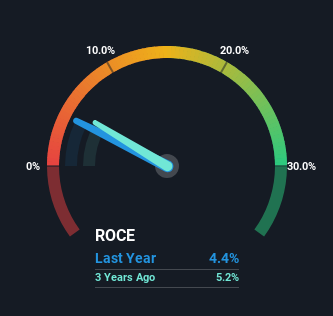- United States
- /
- Electric Utilities
- /
- NasdaqGS:EVRG
Investors Met With Slowing Returns on Capital At Evergy (NASDAQ:EVRG)

What trends should we look for it we want to identify stocks that can multiply in value over the long term? Firstly, we'll want to see a proven return on capital employed (ROCE) that is increasing, and secondly, an expanding base of capital employed. Put simply, these types of businesses are compounding machines, meaning they are continually reinvesting their earnings at ever-higher rates of return. However, after investigating Evergy (NASDAQ:EVRG), we don't think it's current trends fit the mold of a multi-bagger.
Return On Capital Employed (ROCE): What Is It?
If you haven't worked with ROCE before, it measures the 'return' (pre-tax profit) a company generates from capital employed in its business. The formula for this calculation on Evergy is:
Return on Capital Employed = Earnings Before Interest and Tax (EBIT) ÷ (Total Assets - Current Liabilities)
0.044 = US$1.3b ÷ (US$32b - US$3.3b) (Based on the trailing twelve months to June 2024).
Therefore, Evergy has an ROCE of 4.4%. In absolute terms, that's a low return but it's around the Electric Utilities industry average of 4.7%.
View our latest analysis for Evergy

In the above chart we have measured Evergy's prior ROCE against its prior performance, but the future is arguably more important. If you're interested, you can view the analysts predictions in our free analyst report for Evergy .
What Does the ROCE Trend For Evergy Tell Us?
The returns on capital haven't changed much for Evergy in recent years. Over the past five years, ROCE has remained relatively flat at around 4.4% and the business has deployed 28% more capital into its operations. Given the company has increased the amount of capital employed, it appears the investments that have been made simply don't provide a high return on capital.
The Bottom Line On Evergy's ROCE
Long story short, while Evergy has been reinvesting its capital, the returns that it's generating haven't increased. And with the stock having returned a mere 16% in the last five years to shareholders, you could argue that they're aware of these lackluster trends. So if you're looking for a multi-bagger, the underlying trends indicate you may have better chances elsewhere.
If you want to know some of the risks facing Evergy we've found 3 warning signs (1 is concerning!) that you should be aware of before investing here.
For those who like to invest in solid companies, check out this free list of companies with solid balance sheets and high returns on equity.
Valuation is complex, but we're here to simplify it.
Discover if Evergy might be undervalued or overvalued with our detailed analysis, featuring fair value estimates, potential risks, dividends, insider trades, and its financial condition.
Access Free AnalysisHave feedback on this article? Concerned about the content? Get in touch with us directly. Alternatively, email editorial-team (at) simplywallst.com.
This article by Simply Wall St is general in nature. We provide commentary based on historical data and analyst forecasts only using an unbiased methodology and our articles are not intended to be financial advice. It does not constitute a recommendation to buy or sell any stock, and does not take account of your objectives, or your financial situation. We aim to bring you long-term focused analysis driven by fundamental data. Note that our analysis may not factor in the latest price-sensitive company announcements or qualitative material. Simply Wall St has no position in any stocks mentioned.
About NasdaqGS:EVRG
Evergy
Engages in the generation, transmission, distribution, and sale of electricity in the United States.
Solid track record, good value and pays a dividend.
Similar Companies
Market Insights
Community Narratives



